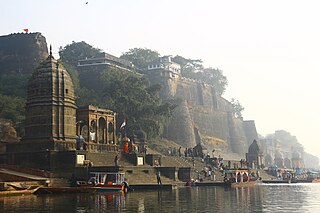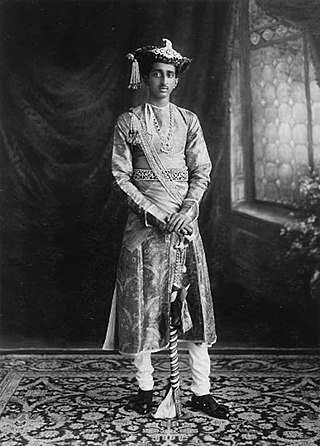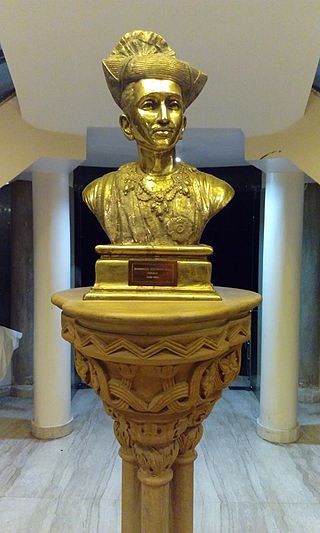
Madhya Pradesh is a state in central India. Its capital is Bhopal, and the largest city is Indore, with Gwalior, Jabalpur, Ujjain, Dewas, Sagar, Satna, and Rewa being the other major cities. Madhya Pradesh is the second largest Indian state by area and the fifth largest state by population with over 72 million residents. It borders the states of Uttar Pradesh to the northeast, Chhattisgarh to the east, Maharashtra to the south, Gujarat to the west, and Rajasthan to the northwest.

Indore is the largest and most populous city in the Indian state of Madhya Pradesh. It is consistently ranked as the cleanest city in India. It serves as the headquarters of both the Indore District and the Indore Division. It is also considered as the state education hub and houses campuses of both the Indian Institute of Technology and the Indian Institute of Management. Located on the southern edge of Malwa Plateau, at an average altitude of 553 meters (1,814 ft) above sea level, it has the highest elevation among major cities of Central India. The city is 190 km (120 mi) west of the state capital of Bhopal. It is 57 km (35 mi) from Ujjain and 35 km (20 mi) from Dewas. Indore had a census-estimated 2011 population of 1,994,397 and 3,570,295. The city is distributed over a land area of just 530 square kilometres (200 sq mi), making Indore the most densely populated major city in the central province.

Dewas is a city in the Malwa region of the Indian state of Madhya Pradesh. The municipality was formerly the seat of two 15-Gun Salute state princely states during the British Raj, Dewas Junior state and Dewas Senior state, ruled by the Pawar clan of the Marathas. The city is the administrative capital of Dewas district. Dewas is an industrialised city and houses a government bank note press.
Dhar is a city located in Dhar district of the Malwa region in the state of Madhya Pradesh, India. The city is the administrative headquarters of the Dhar district. Before Indian independence from Great Britain, it was the capital of the Dhar princely state.

Maheshwar is a town, near Khargone city in Khargone district of Madhya Pradesh state, in central India. It is located on State Highway-38 ,13.5 km east of National Highway 3 and 91 km from Indore, the commercial capital of the state. The Town lies on the north bank of the Narmada River. It was the kingdom of Chaktavartin Samrat Sahastraarjun, Kartavirya Arjuna a Heheya king. Lately, after many years, it was the capital of the Malwa during the Maratha Holkar reign till 6 January 1818, when the capital was shifted to Indore by Malhar Rao Holkar III.

The Holkars were a family that was part of the Maratha Empire, which held the rank of subahdar under Peshwa Baji Rao I. When the Maratha Empire began to weaken due to internal clashes, the Holkars declared themselves the rulers of Indore in Central India, existing as an autonomous member of the Maratha Empire until 1818. Later, their kingdom became a princely state under the protectorate of British India.

The Indore District is a district of Madhya Pradesh state in central India. It is believed that the city is named after its Indreshwar Mahadev Temple, Where Indra is the presiding deity. The Gupta inscriptions name Indore as "Indrapura". It is also called the administrative capital. This district forms part of the Indore Division.
Barwaha is a municipality and sub district in Khargone district in the state of Madhya Pradesh, India situated on the banks of Narmada river. Barwaha is second biggest city of District after Khargone city. The Barwaha city is divided into 28 wards for which elections are held every 5 years. The Barwaha Municipality has population of 61,973 of which 32,940 are males while 29,033 are females as per report released by Census India 2011. Literacy rate of Barwaha is 87.27% higher than state average of 69.32%. In Barwaha, Male literacy is around 92.73% while female literacy rate is 81.23%.
Lalbagh, also spelled Lal Bagh is a term in Hindustani and Persian language. Its meanings include "red garden" and "beloved garden".

Holkar Cricket Stadium is located in Indore, Madhya Pradesh, India. It is owned and operated by Madhya Pradesh Cricket Association and serves as its headquarter. It is the home ground of Madhya Pradesh cricket team, MP women's team.

Rajwada, also known as the Holkar Palace or Old Palace, is an important historical palace in Indore that was constructed by the Holkars of the Maratha empire, around 2 centuries ago. An example of the fine architectural skill and magnificence of those times, the palace is an impressive 7 storey structure that is placed near the Holkar Chhatris. One of the popular tourist attractions of Indore, Rajwada Palace is one of the oldest structures too. The construction of the palace was started by Malhar Rao Holkar, the founder of Holkar Dynasty in the year 1747 A.D. This remarkable structure is placed in Khajuri Bazaar, right in the middle of the city. The Rajwada palace has the Shiv Vilas Palace on the right and faces a well-maintained garden that has a statue of Maharani Ahilya Bai Holkar, fountains and an artificial waterfall.

Maharajadhiraj Raj Rajeshwar Sawai Shri Sir Yeshwant Rao II Holkar XIV Bahadur was the Maharaja of Indore belonging to the Holkar dynasty of the Marathas. With his first wife, he became known for a life of elegance and extravagance in the 1920s and 30s.

Maharajadhiraj Sir Raj Rajeshwar Sawai Shri Tukojirao III Holkar XIII Bahadur was the Maharaja of Indore State in central India between 1903 and 1926.

Indore State, also known as Holkar State, was a kingdom in India. Its rulers belonged to the Maratha Holkar dynasty. After 1857, Indore became a 19-gun salute princely state under the British Raj.

The Yeshwant Club in Indore, Madhya Pradesh, India, came into existence in 1934 at the behest of Maharaja Sir Tukoji Rao III Holkar of Indore. The club was established out of affection for his son, Yuvraj Yeshwant Rao Holkar. Spread over an expanse of 14 acres, it is one of the living signatures of the rich legacy of the Holkar rulers of Indore State of the Maratha Confederacy. Initially the club was opened for royalty, nobility, aristocracy, and the officers of the Holkar State. Later, its doors were opened for business elites. After Indian independence, admission criteria were revised.
The Narmada Kothi is a palace in the Indian municipality of Barwaha.

The Krishnapura Chhatris, also known as the Krishna Pura Chhatris are three chhatris located in Indore, Madhya Pradesh, India. The structures were built by the Holkars as cenotaphs over the spots where people of importance were cremated, leading to them also being known as the Holkar Chhatris. All three of the Chhatris are located half a kilometer from the city palace, Rajwada, which was also built by the Holkar dynasty.
Manik Bagh, also spelled Manig Bagh, is a palace of the Holkar Maharaja of Indore State in Indore, Madhya Pradesh. The name means "Ruby Garden" or "Gem Garden". It was designed and built by the German architect Eckart Muthesius on behalf of Maharaja Yashwant Rao Holkar II in 1930. On the outside and the inside it was in the Bauhaus and Art Deco style, making it a Gesamtkunstwerk.

Shiv Vilas Palace, also known as the New palace, is a royal residential palace in Indore, built by Maharaja Shivajirao Holkar of the Holkar dynasty and served as the official residence of the Holkars from 1894 to 1920. This palace was built beside their old residence, the Rajwada. The construction was started in 1890 and exhibits Neoclassical architecture. The starting year of construction (1890) coincided with the birth of Maharaja Shivajirao's son and successor, Tukojirao Holkar III. It currently houses a hospital and a few offices. The Shiv Vilas Palace was constructed while the construction of the Lalbagh Palace was in progress and upon its completion, the official residence was shifted to it. Recently, city tours have started to include the palace in their itineraries.















